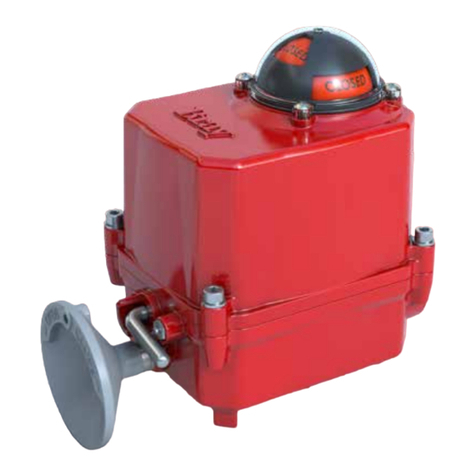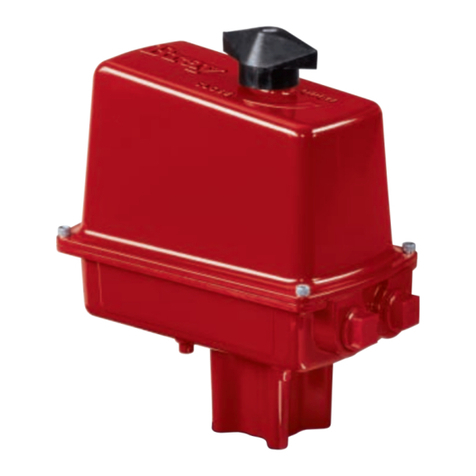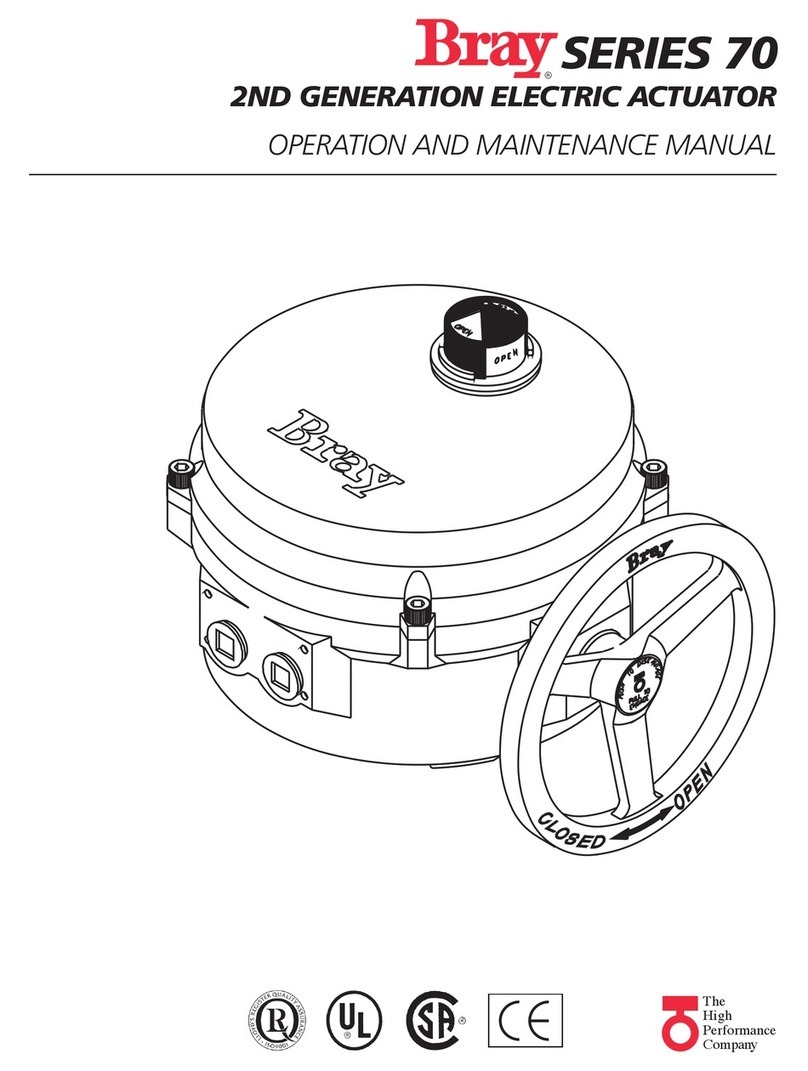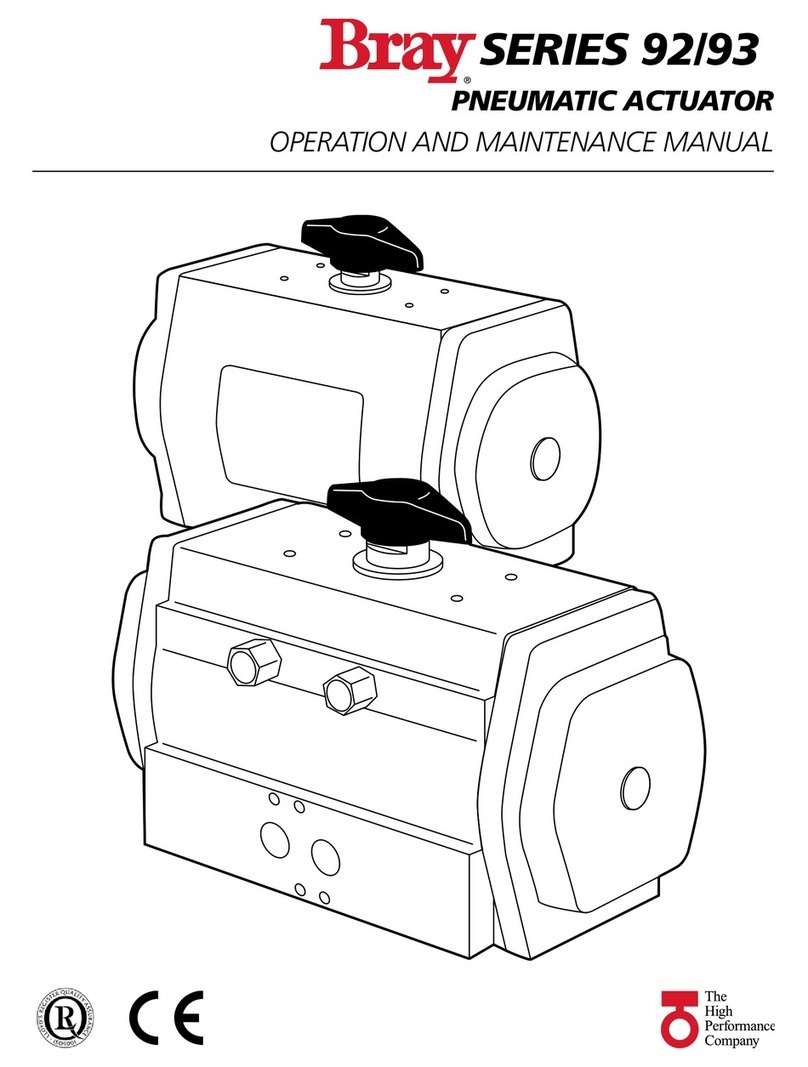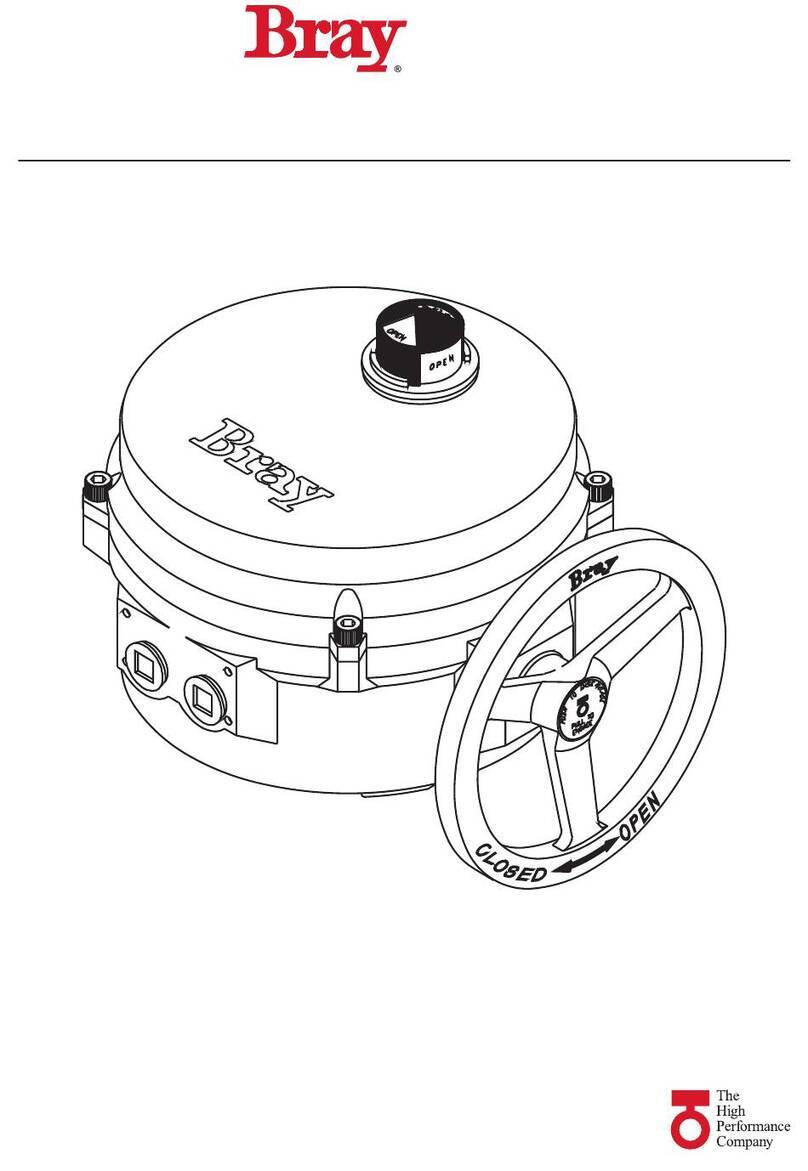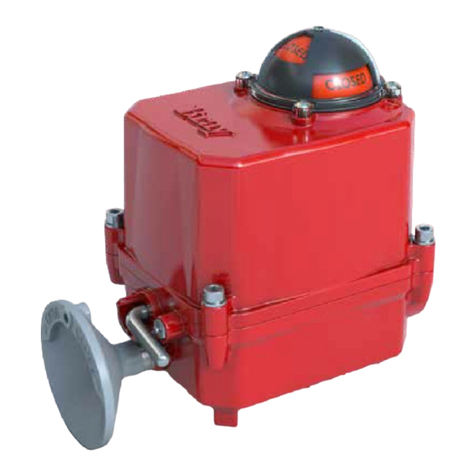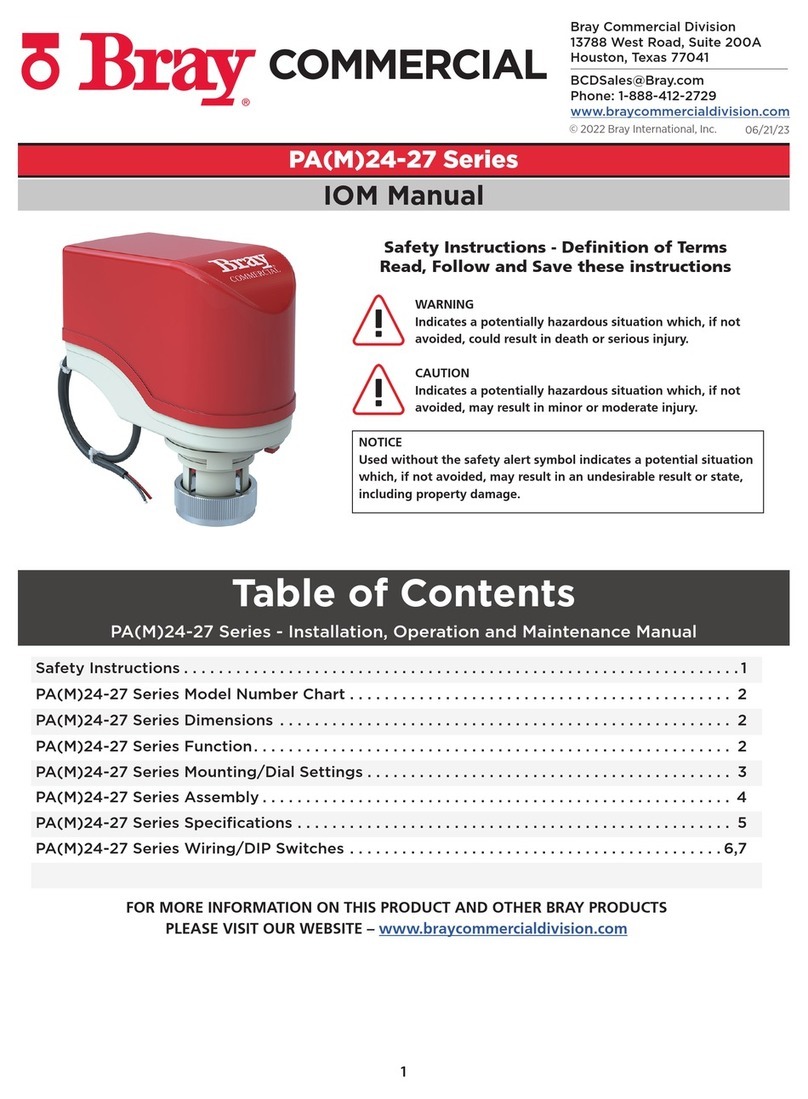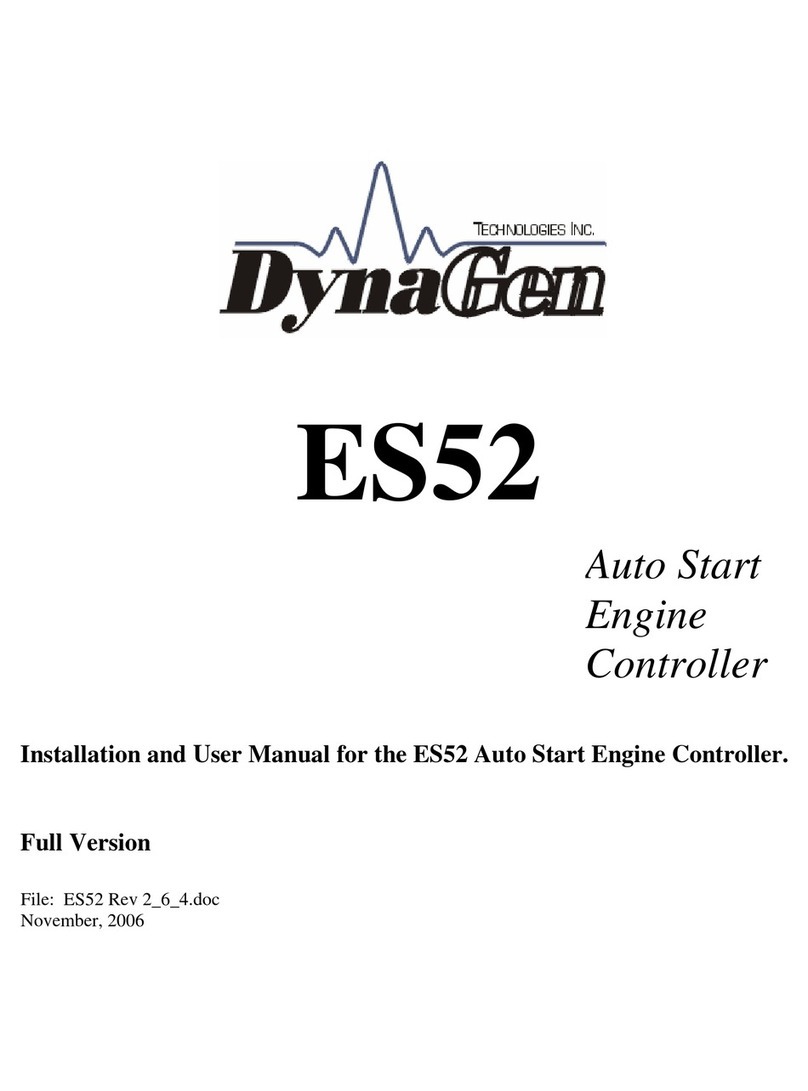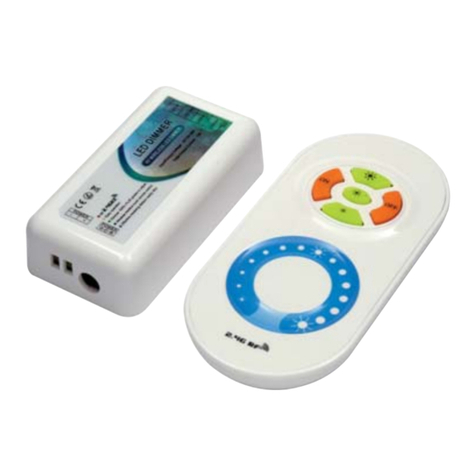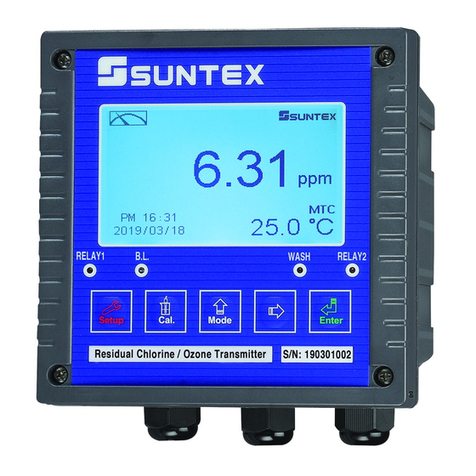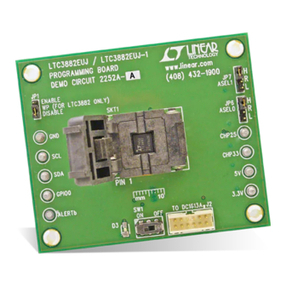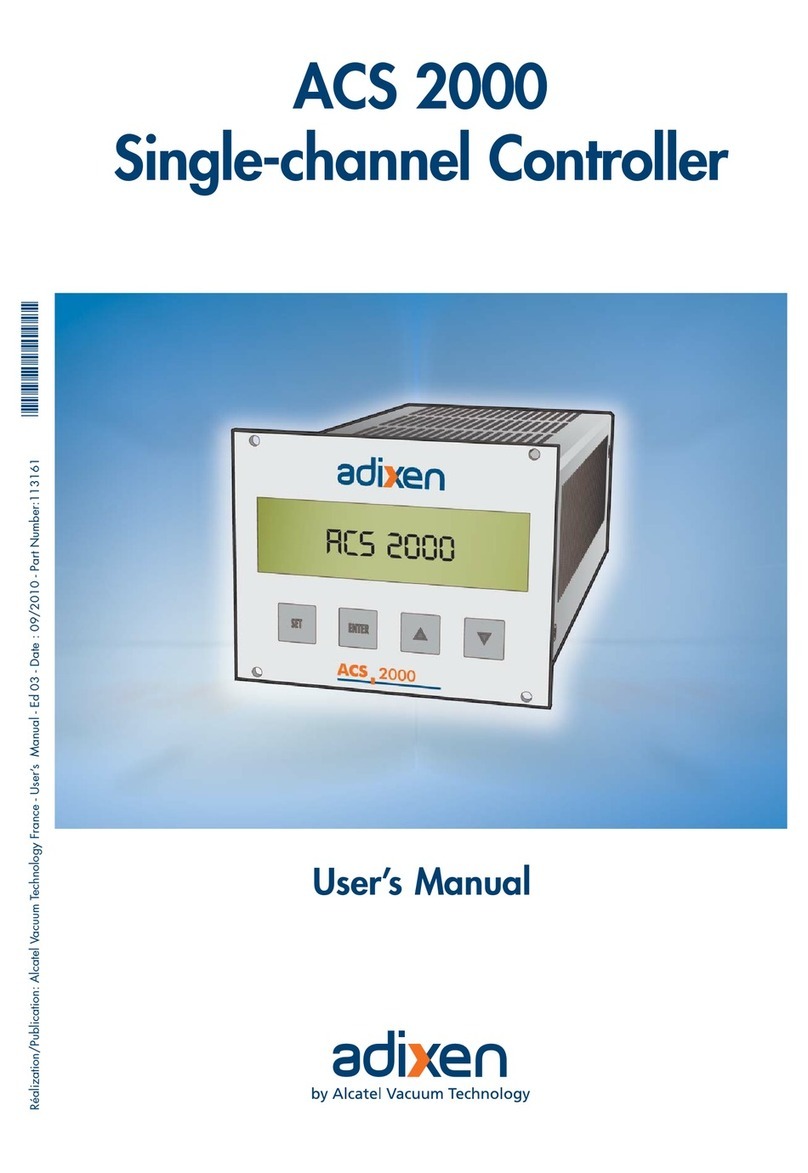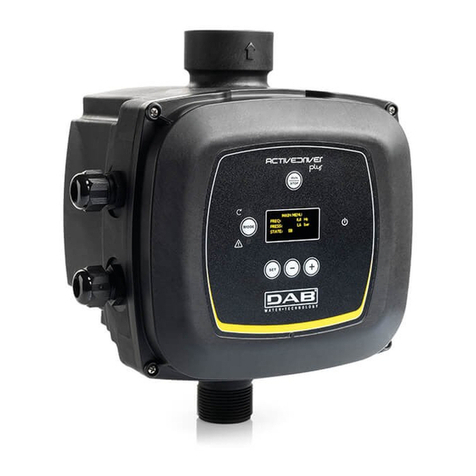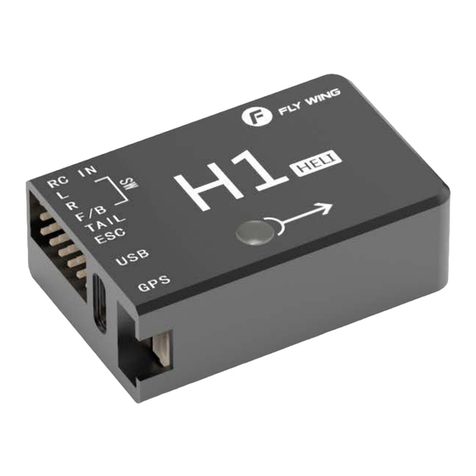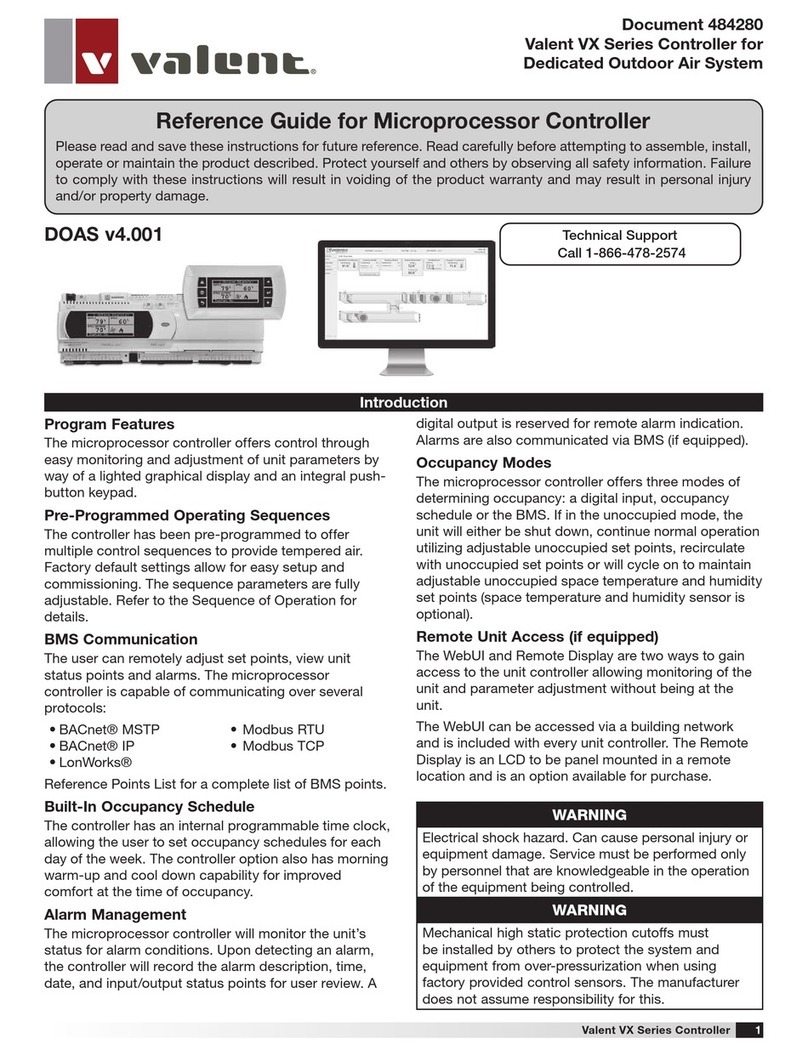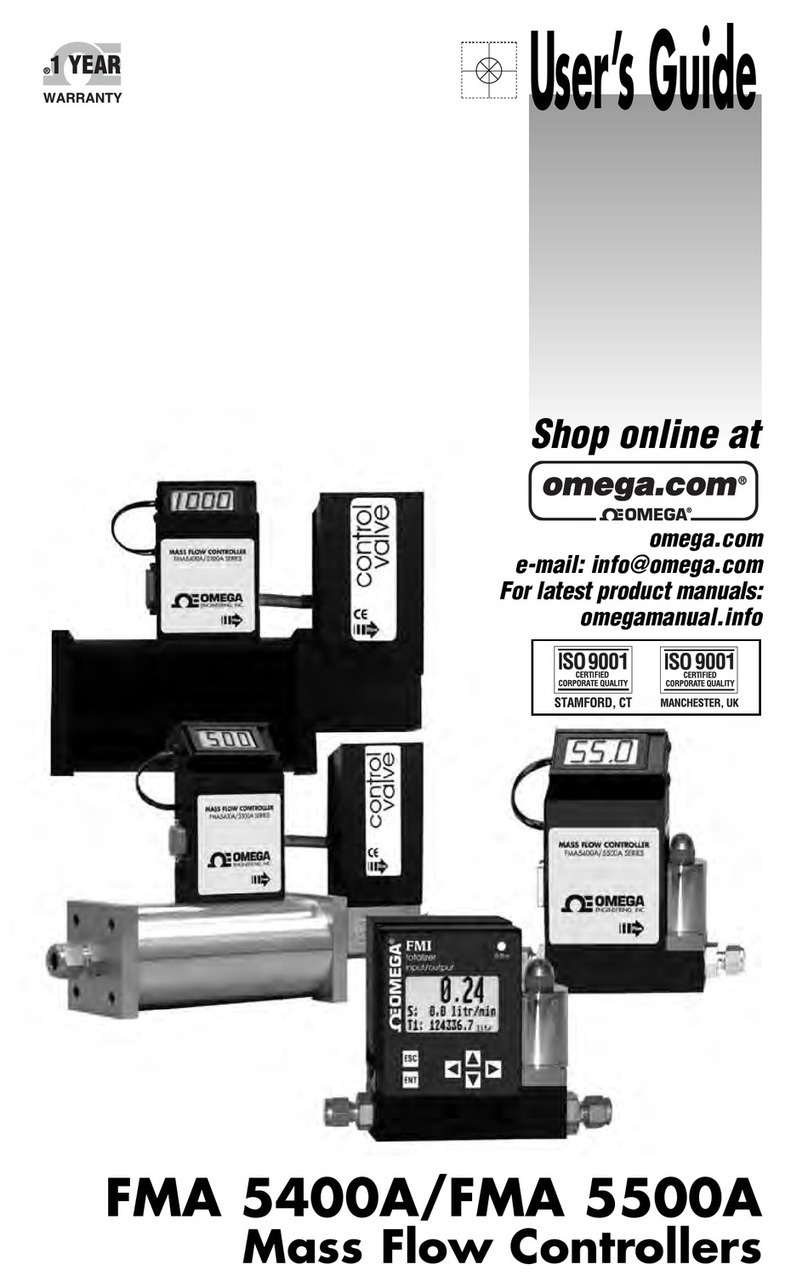Bray Series 70 User manual

Series 70
24V On/Off Electric Actuator
Operation and Maintenance Manual

1
Bray Series 70
24V On/Off Electric Actuator
Operations and Maintenance Manual
For information on this product and other Bray products please visit us at our web page - www.bray.com
TABLE OF CONTENTS
1. Definition of Terms . . . . . . . . . . . . . . . . . . . . . . . . . . . . . . . . . . . . . . . . . . . . . 2
2. Safety . . . . . . . . . . . . . . . . . . . . . . . . . . . . . . . . . . . . . . . . . . . . . . . . . . . 2
3. Storage . . . . . . . . . . . . . . . . . . . . . . . . . . . . . . . . . . . . . . . . . . . . . . . . . . 2
4. Operating your Actuator . . . . . . . . . . . . . . . . . . . . . . . . . . . . . . . . . . . . . . . . . . 3
4.1. Operating by Hand . . . . . . . . . . . . . . . . . . . . . . . . . . . . . . . . . . . . . . . . . . 3
4.2. Operating Electrically . . . . . . . . . . . . . . . . . . . . . . . . . . . . . . . . . . . . . . . . . 3
5. Mounting the Actuator. . . . . . . . . . . . . . . . . . . . . . . . . . . . . . . . . . . . . . . . . . . 3
6. Commissioning. . . . . . . . . . . . . . . . . . . . . . . . . . . . . . . . . . . . . . . . . . . . . . . 4
6.1. Wiring Your Actuator. . . . . . . . . . . . . . . . . . . . . . . . . . . . . . . . . . . . . . . . . 4
6.2. Setting Travel Limit Switches Cams . . . . . . . . . . . . . . . . . . . . . . . . . . . . . . . . . . 4
6.3. Setting Mechanical Travel Stops . . . . . . . . . . . . . . . . . . . . . . . . . . . . . . . . . . . 5
6.4 Configuring your 24V On/Off Controller . . . . . . . . . . . . . . . . . . . . . . . . . . . . . . . 6
6.5 DIP Switch Setting. . . . . . . . . . . . . . . . . . . . . . . . . . . . . . . . . . . . . . . . . . . 6
7. Field or Factory Installable Options . . . . . . . . . . . . . . . . . . . . . . . . . . . . . . . . . . . . . 7
7.1. Heater . . . . . . . . . . . . . . . . . . . . . . . . . . . . . . . . . . . . . . . . . . . . . . . . 7
7.2. Control Station . . . . . . . . . . . . . . . . . . . . . . . . . . . . . . . . . . . . . . . . . . . . 8
7.3. Auxiliary Switches . . . . . . . . . . . . . . . . . . . . . . . . . . . . . . . . . . . . . . . . . . 8
7.4. Torque Switches . . . . . . . . . . . . . . . . . . . . . . . . . . . . . . . . . . . . . . . . . . . 8
7.5. Battery Backup Unit . . . . . . . . . . . . . . . . . . . . . . . . . . . . . . . . . . . . . . . . . 8
7.6. Spinner . . . . . . . . . . . . . . . . . . . . . . . . . . . . . . . . . . . . . . . . . . . . . . . . 9
7.7. Receptacles (Quick Connectors) . . . . . . . . . . . . . . . . . . . . . . . . . . . . . . . . . . . 9
Appendix A . . . . . . . . . . . . . . . . . . . . . . . . . . . . . . . . . . . . . . . . . . . . . . . . . 10
A.1. Troubleshooting Guide . . . . . . . . . . . . . . . . . . . . . . . . . . . . . . . . . . . . . . . 10
A.2. Actuator Troubleshooting Chart . . . . . . . . . . . . . . . . . . . . . . . . . . . . . . . . . . 10
A.3. Troubleshooting Example. . . . . . . . . . . . . . . . . . . . . . . . . . . . . . . . . . . . . . 11
Appendix B . . . . . . . . . . . . . . . . . . . . . . . . . . . . . . . . . . . . . . . . . . . . . . . . . 12
B.1. Basic Tools . . . . . . . . . . . . . . . . . . . . . . . . . . . . . . . . . . . . . . . . . . . . . 12

2
Bray Series 70
24V On/Off Electric Actuator
Operations and Maintenance Manual
1. DEFINITION OF TERMS
Indicates a potentially hazardous situation which, if not avoided, could result in death or
serious injury.
Indicates a potentially hazardous situation which, if not avoided, may result in minor or
moderate injury.
NOTICE Used without the safety alert symbol indicates a potential situation which, if not avoided,
may result in an undesirable result or state, including property damage.
2. SAFETY
This device left the factory in proper condition to be safely
installed and operated in a hazard-free manner. The notes
and warnings in this document must be observed by the
user to ensure hazard-free operation of this device.
All necessary precautions need to be taken to prevent
damage due to rough handling, impact, or improper
storage. Do not use abrasive compounds to clean the
device, or scrape its surfaces with any objects.
Configuration and setup procedures for this device are
described in this manual. Proper configuration and setup
are required for the safe operation of this device.
The control system in which this device is installed must
have proper safeguards to prevent injury to personnel,
or damage to equipment, should a failure of system
components occur.
Installation, commissioning, operation and maintenance
of the unit must be performed under strict observation
of all applicable codes, standards and safety regulations.
The actuator must only be installed, commissioned,
operated and repaired by qualified personnel.
As per this document, a qualified person is one who is
trained in:
1. The operation and maintenance of electrical equipment
and systems in accordance with established safety
practices.
2. Procedures to energize, de-energize, ground, tag and
lockout electrical circuits and equipment in accordance
with established safety practices.
3. The proper use and care of personal protective
equipment (PPE) in accordance with established safety
practices.
This document does not cover every detail about every
version of the product described. It does not take into
account every potential occurrence concerning the
installation, operation, maintenance and use of this device.
If situations transpire that are not documented in sufficient
detail, please request the required information from the
Bray Distributor or Representative responsible for your area.
3. STORAGE
Store units on a shelf or wooden pallet in order to protect
against floor dampness.
Cover the units to protect against dust and dirt.
To prevent condensation inside these units, maintain a
near constant external temperature and store in a well-
ventilated, clean, dry room away from vibration. For units
with an internal heater, power should be supplied to the
heater via conduit entry with an appropriate sealing gland.
Actuators are not weatherproof unless they are properly
installed on the valve or prepared for storage. Bray will
not accept responsibility for deterioration caused on-site.
Read and Follow These Instructions
Save These Instructions

3
Bray Series 70
24V On/Off Electric Actuator
Operations and Maintenance Manual
4. OPERATING YOUR ACTUATOR
4.1. Operating by Hand
To engage the manual override, simply pull the handwheel
to its outermost position. A yellow stripe is revealed to
visually indicate manual override engagement as shown in
Figure 1.
Figure 1.
Yellow Stripe
Handwheel is engaged, revealing the yellow stripe.
Once the manual override is engaged, rotating the
handwheel in the clockwise direction will rotate the output
shaft in the clockwise (close) direction and vice-versa.
To disengage the manual override, the handhwheel needs
to be pushed towards the actuator until the ‘yellow stripe’
is hidden.
A label on the handwheel hub warns users not to exceed
a specific ‘rim pull’ force, for each size of actuator.
If the ‘rim pull’ force is exceeded, the roll pin securing the
handwheel onto the manual override shaft is designed to
shear, thus preventing serious internal gearing damage.
4.2. Operating Electrically
To control the actuator remotely from a process controller,
user must apply 24 VAC or 24 VDC to the actuator. This
control signal voltage can be applied locally or remotely
from a process controller.
Verify that the main electric power supplied to the
actuator is in compliance with the specifications on the
actuator label
Engaging the handwheel before or during the application
of a control signal voltage will prevent the actuator motor
from operating.
If torque switches are installed in the actuator, an
overtorque condition will also prevent the actuator motor
from operating.
5. MOUNTING THE ACTUATOR
All Bray Series 70 electric actuators are suitable for direct
mounting on Bray butterfly valves. With proper mounting
hardware, the S70 actuator can be installed onto other
quarter-turn valves or devices as well.
NOTICE
The standard mounting position for the actuator is to
orient the base of the actuator parallel to the pipeline.
If the actuator is to be mounted on a vertical pipe, it
is recommended that the unit be positioned with the
conduit entries on the bottom to prevent condensation
entering the actuator through its conduits.
Follow the steps below to mount the actuator onto the
valve.
1. Manually operate the actuator until the output shaft of
the actuator is in line with the valve stem. If possible,
select an intermediate position for both the valve and
actuator.
2. If required, place the proper adapter onto the valve
stem. It is recommended that a small amount of ‘anti-
seize’ lubricant be applied to the adapter to ease
assembly.
3. Mount the actuator onto the valve stem. It may be
necessary to operate the actuator manually to align the
valve and actuator bolt patterns.
4. Install the furnished mounting studs by threading them
all the way into the actuator base.
5. Fasten the mounting studs in place with furnished hex
nuts and lock washers.

4
Bray Series 70
24V On/Off Electric Actuator
Operations and Maintenance Manual
6. COMMISSIONING
6.1. Wiring Your Actuator
Turn off all power and lockout/tagout service panel
before installing or modifying any electrical wiring.
1. Take the actuator cover off and place it in a safe
location.
2. Each actuator is provided with two conduit entries. Use
one for power and the other for control wiring.
3. Wire the actuator as per the wiring diagram attached
to the inside of the actuator cover.
a. A minimum of 18 AWG wire is recommended for all
field wiring.
b. The terminals on the actuator switch plate, On/Off
Controller or Servo NXT accepts wire sizes ranging
from 14 to 22 AWG.
c. The conduit connections must be properly sealed to
maintain the weatherproof integrity of the actuator
enclosure.
Figure 2. Sample field wiring diagram for Series 70 24V
On/Off Actuator with auxiliary switches.
6.2. Setting Travel Limit Switches Cams
Bray uses its patented cam design along with 2 SPDT
mechanical switches to set the ‘Open’ and ‘Close’ position
of the valve.
The green cam actuates the ‘open’ switch when the
actuator reaches the ‘open’ position. Similarly, the red cam
actuates the ‘close’ switch when the actuator reaches the
‘close’ position.
Standard factory setting of the travel limit switches allows
90° travel between open and close positions. Cams for
each switch are adjustable for applications where less than
90° degree travel is desired between the open and closed
positions.
Figure 3. Two SPDT Travel Limit Switches.

5
Bray Series 70
24V On/Off Electric Actuator
Operations and Maintenance Manual
Follow the steps below to adjust the travel limit cams.
1. Remove the indicator rotor by pulling it away from the
indicator shaft as shown in Figure 4.
Figure 4.
Indicator Rotor
Indicator rotor pulled up from the indicator shaft.
2. Manually operate the actuator clockwise until the valve
reaches the desired ‘close’ position.
3. Loosen the cam locking screw shown in Figure 5.
Figure 5.
UPPER GREEN
“OPEN” CAM
LOWER RED
“CLOSE” CAM
POT DRIVE GEAR
“BLACK” NOT SHOWN
FOR CLARITY REASONS
CAM ADJUSTMENT KNOB
(ONLY ADJUST IF LOCKING
SCREW IS SLACKENED)
CAM
LOCKING
SCREW
Top view of the indicator cam shaft.
NOTE: It is possible that the rotation of one cam will move
the other cam. If this occurs, hold the other knobs or cams
during adjustment.
4. Rotate the red cam adjustment knob by hand or with
a flat head screwdriver until the red cam lobe activates
(depresses) the ‘close’ switch from a clockwise
direction.
5. Manually operate the actuator counterclockwise until
the valve reaches the desired ‘open’ position.
6. Rotate the green cam adjustment knob until the green
cam lobe activates (depresses) the ‘open’ switch from a
counterclockwise direction.
7. After both travel switch adjustments have been
completed, tighten the cam locking screw and place
the indicator rotor back on the indicator shaft.
6.3. Setting Mechanical Travel Stops
Mechanical travel stops are designed to prevent overtravel
while manually operating the actuator. They are not
designed to stop the electric motor.
Mechanical travel stops are located outside the actuator
base for easy readjustment. Stainless steel lock nuts with
O-ring seals hold the travel stops securely in place as shown
in Figure 6
Figure 6. Mechanical Travel Stops (CW Close).
Follow the steps below to set the mechanical travels stops.
1. Manually drive the actuator to the closed position.
2. Once the actuator is in the closed position, rotate the
handwheel clockwise:
• ½ turn for Housing Size 6.
• 1 turn for Housing Size 12.
• ½ turn for Housing Size 30.
NOTE:
Maximum Actuator Torque Housing Size
600 Lb-In 6
2000 Lb-In 12
5000 Lb-In 30
3. Adjust the closed travel stop bolt until it contacts the
output segment gear and lock it in position with the
locknut.
4. Manually drive the actuator to the open position.
5. Once the actuator is in the open posiiton, rotate the
handwheel counterclockwise:
• ½ turn for Housing Size 6.
• 1 turn for Housing Size 12.
• ½ turn for Housing Size 30.
6. Adjust the open travel stop bolt until it contacts the
output segment gear and lock it in position with the
locknut.
Close
Travel
Stop
Open
Travel
Stop

6
Bray Series 70
24V On/Off Electric Actuator
Operations and Maintenance Manual
6.4 Configuring your 24V On/Off Controller
Every Series 70 24V On/Off Actuator is fitted with a 24V
On/Off Controller as shown in Figure 7.
Figure 7. S70 24V On/Off Actuator.
The 24V On/Off Controller offers 3-wire control for the
actuator.
To drive the actuator in the open direction, 24 VDC or
24 VAC power must be applied between the ‘Open’ and
‘Common’ terminals of the controller.
Similarly, to drive the actuator in the close direction, 24VDC
or 24VAC power must be applied to the ‘Close’ and
‘Common’ terminals of the controller.
When the command signal is first applied, the Controller
will wait for 1 second before powering the actuator motor.
This delay is necessary to prevent a simultaneous reversal of
the motor if an abrupt change in command signal direction
occurs (instant reverse delay).
Once the actuator has reached the ‘Open’ or ‘Close’
position, the travel limit switch is activated and the
controller turns off power to the motor.
NOTICE
Verify that the main electric power supplied to the
actuator is in compliance with the specifications on the
product label
6.5 DIP Switch Setting
The DIP switches on the 24V On/Off Controller are
dependent on the installation of mechanical torque
switches in the actuator. Table 1 shows the DIP switch
settings for the 24V On/Off Controller.
Table 1
Mechanical Torque
Switches installed
DIP Switch 1 DIP Switch 2
YES OFF ON
NO OFF OFF
Figure 8. DIP switch settings when mechanical torque
switches are installed in an actuator.
NOTICE
An engaged torque switch will prevent the actuator
motor from operating in the over torque direction.
The 24V On/Off Controller has four LED’s for status and
fault indication as shown in Figure 9.
On/Off
Controller

7
Bray Series 70
24V On/Off Electric Actuator
Operations and Maintenance Manual
FAULT
POWER
OPEN
CLOSE
Figure 9. 24V On/Off Controller LEDs.
The LED flash codes for the 24V On/Off Controller are
described in Table 2 below.
Table 2
LED Behavior Meaning
‘Pwr’ LED flashes green
every ½ second
The actuator has power and is
operational.
‘Fault’ LED glows red
Hand-wheel is engaged/pulled
out
The Open or Close Torque
switch is engaged
Both the travel limit switches
are engaged at the same time
‘Open’ LED glows green Actuator is being driven in the
open direction.
‘Close’ LED glows red Actuator is being driven in the
close direction
7. FIELD OR FACTORY INSTALLABLE OPTIONS
7.1. Heater
To prevent condensation from forming inside the actuator,
Bray offers an optional heater as a field or a factory
installable option.
The heater is thermostatically controlled. It self-regulates by
increasing or decreasing its electrical resistance relative to
its temperature.
Figure 10. Heater installed on an S70 switch plate.
NOTICE
a. The heater must have a constant power supply to be
effective.
b. The heater surface can reach temperatures in excess
of 200° Celsius.
The heater surface can reach temperatures in excess of
200° Celsius

8
Bray Series 70
24V On/Off Electric Actuator
Operations and Maintenance Manual
7.2. Control Station
Bray’s Control Station gives the operator the ability to
locally drive the actuator with electrical power; overriding
the control signal from the process controller.
The control station has a red (close) and green (open)
light to provide end of travel indication. It also has two
3-position switches as shown in Figure 11.
Figure 11.
Switch 2
Green
Light
Switch 1
Red
Light
S70 with the Control Station.
Switch 1 lets the operator choose between the following
three modes of operation:
1. Local: In this mode, using switch 2 the operator can
drive the actuator to open or close position, or stop the
actuator; overriding any control signal from the process
controller.
2. Off: In this mode, the actuator can only be operated
manually.
3. Remote: In this mode, the Actuator is controlled
remotely from a process controller using a 24 VDC or
24 VAC signal.
NOTE:
a. Control Station can also be ordered with key lockable
switches.
b. Control Station requires a dedicated set of auxiliary
switches. These switches are required for turning on or
off the lights on the control station to locally indicate
actuator position.
c. Control Station does not contain terminal strips. All
wiring is done directly to the switches and lights via 2
x 3/4” NPT holes in the bottom of the control station
housing. Wire the process controller to the control
station in accordance to the wiring diagram provided.
d. Ordering the Control Station with optional pin
connector receptacles will eliminate the necessity of
field wiring.
7.3. Auxiliary Switches
Auxiliary switches are a pair of dry-contact (voltage free)
SPDT mechanical switches used to indicate travel position
to remote customer control systems.
Figure 12. Fixed auxiliary switches installed in an actuator.
NOTE:
a. Fixed Auxiliary switches activate 3° before the travel
limit switches. They are available as a factory and field
installable option.
b. Adjustable auxiliary switches can be set to any position.
They are available as a factory or field installable option.
7.4. Torque Switches
Mechanical Torque switches are designed to interrupt
power to the motor windings when the actuator torque
exceeds the calibrated factory setting.
Mechanical Torque switches are a factory installed and
calibrated option available for all Series 70 units.
7.5. Battery Backup Unit
To meet customer needs, Bray offers a Battery Backup Unit
(BBU) for the 24 V Series 70 Electric Actuator.
In the event of power failure, the BBU will switch the
actuator to battery power to reach its fail position. After
the actuator has reached its fail position, the BBU goes to
‘Standby Mode’ until external power is restored.
Once external power has been restored, the actuator
returns to the position corresponding to the control signal
present.

9
Bray Series 70
24V On/Off Electric Actuator
Operations and Maintenance Manual
Figure 13. S70 with Battery Backup Unit.
Battery Backup Unit is available as a factory installable
option. For more information, please refer to the ‘S70 24V
Actuator with BBU’ Manual. This manual is available on the
company website (www.bray.com).
7.6. Spinner
A spinner is available as an attachment to the actuator
handwheel to ease and speed the manual operation of the
actuator.
Figure 14. S70 with Handwheel Spinner Attached.
NOTE:
a. Care should be exercised in the use of spinner equipped
handwheels.
b. Rapid operation of the handwheel to close the valve
may cause water hammer.
c. Rapid travel into a travel stop may also cause damage.
7.7. Receptacles (Quick Connectors)
For quick and easy field wiring, Bray offers plug-in recep-
tacles. Cordsets to fit these connectors can also be ordered
in several lengths.
Figure 15. S70 with a 5-pin receptacle and the corres-
ponding cordset.

10
Bray Series 70
24V On/Off Electric Actuator
Operations and Maintenance Manual
APPENDIX A
A.1. Troubleshooting Guide
The Series 70 24V On/Off actuator is easy to configure and operate, but if problems do occur, the following guide can assist
in troubleshooting.
The first step is to observe the ‘Pwr’ LED on the 24V On/Off Controller to verify that proper electrical power has been
connected. If the ‘Pwr’ LED is flashing green, it means that the actuator has been powered correctly.
Next, observe the Fault LED. If the ‘Fault’ LED on the 24V On/Off Controller is turned on red, refer to Table 2 on page 7 of
the manual to determine the root cause of the fault. After the root cause of the fault has been addressed, the ‘Fault’ LED
should turn off.
If the problem still persists refer to the Actuator Troubleshooting Chart below.
A.2. Actuator Troubleshooting Chart
Problem Possible Cause Solutions
Actuator motor does not run in either
direction and the ‘Pwr’ LED on the
24V On/Off Controller is flashing
green
Manual override/handwheel is engaged. Push handwheel in all the way
Wiring is incorrect Check wiring and power supply
Actuator operates in reverse directions Field wiring is reversed Rewire field wiring per wiring
diagram
Actuator does not fully close valve (or
open valve)
Limit switches are set incorrectly Readjust travel limit switches
Mechanical travel stops are set
incorrectly Adjust mechanical travel stops
Valve torque requirement is higher than
actuator output
Manually override out of seat, try
angle seating or larger actuator
Optional torque switches are activating Valve torque exceeds actuator torque
rating - consult factory
Voltage power supply is low Check power source
Corrosion inside unit Water leaking in Check all seals and possible water
entry through conduit
Actuation only runs in one direction Wiring is incorrect Correct field wiring
Incorrect control signal Check/correct the control signal wire

11
Bray Series 70
24V On/Off Electric Actuator
Operations and Maintenance Manual
A.3. Troubleshooting Example
The following example demonstrates a typical troubleshooting process.
Assume these starting conditions:
1. The handwheel is engaged (pulled away from the actuator).
2. The 24V On/Off Controller has been configured to enable torque switches but torque switches are not physically
installed on the actuator.
3. 24VAC signal has been properly applied between the ‘Open’ and ‘Close’ terminals of the 24V On/Off Controller. The
‘Pwr’ LED is flashing indicating the control signal has been properly applied.
The ‘Fault’ LED on the 24V On/Off Controller is turned on red. Evaluate all possible reasons for the ‘Fault’ LED to be turned
on as per Table 2 on page 7 of this manual.
1. Observe if the handwheel is engaged. In this case, the handwheel is engaged. Disengage the handwheel by pushing it
in to eliminate a possible reason for the ‘Fault’ LED to be turned on red.
2. Evaluate if the limit switches have been correctly wired.
3. Check if the 24V On/Off Controller has been configured correctly to enable or disable the torque switches. In this case,
torque switches have not been installed in the actuator but the 24V On/Off Controller has been configured to enable
the torque switches. Correctly configure the 24V On/Off controller correctly to disable the toque switches as per Table
1 (on page 6).
4. The ‘Fault’ LED on the 24V On/Off Controller turns off and the actuator is now ready for service.

12
Bray Series 70
24V On/Off Electric Actuator
Operations and Maintenance Manual
APPENDIX B
B.1. Basic Tools
Common To All Units
Terminal connections, cam adjustment Screwdriver, 1⁄4" tip flat tip blade
All switches, terminal strip, torque switch plate Screwdriver, No.1 Phillips
Switchplate screws Screwdriver, No. 2 Phillips
Housing Size 6
Mounting nuts Wrench, 1⁄2"
Cover captivated capscrews Hex key, 1⁄4"
Travel stop adjusting bolts Wrench, 7⁄16"
Travel stop jam nuts Wrench, 7⁄16"
Conduit Entry Plug (1⁄2” NPT) Hex key, 3⁄8"
Housing Size 12
Mounting nuts (small pattern) Wrench, 1⁄2"
Mounting nuts (large pattern) Wrench, 3⁄4"
Cover captivated capscrews Hex key, 5⁄16"
Travel stop adjusting bolts Wrench, 9⁄16"
Travel stop jam nuts Wrench, 9⁄16"
Conduit Entry Plug (3⁄4” NPT) Hex key, 9⁄16"
Housing Size 30
Mounting nuts (small pattern) Wrench, 3⁄4"
Mounting nuts (large pattern) Wrench, 11⁄8"
Cover captivated capscrews Hex Key, 3⁄8”
Travel stop adjusting bolts Wrench, 3⁄4"
Travel stop jam nuts Wrench, 3⁄4”
Conduit Entry Plug (3⁄4” NPT) Hex key, 9⁄16"

13
Bray Series 70
24V On/Off Electric Actuator
Operations and Maintenance Manual

14
Bray Series 70
24V On/Off Electric Actuator
Operations and Maintenance Manual

Bray Series 70
24V On/Off Electric Actuator
Operations and Maintenance Manual
All statements, technical information, and recommendations
in this bulletin are for general use only. Consult Bray
representatives or factory for the specic requirements and
material selection for your intended application. The right
to change or modify product design or product without prior
notice is reserved. Patents issued and applied for worldwide.
Bray®is a registered trademark of
Bray International, Inc.
© 2015 Bray International, Inc. All rights reserved.
OM_70_24VOnOff_11-2015
Bray Controls
A Division of Bray International, Inc.
13333 Westland East Blvd.
Houston, Texas 77041
Tel: 281.894.5454 • www.bray.com
Other manuals for Series 70
9
Table of contents
Other Bray Controllers manuals
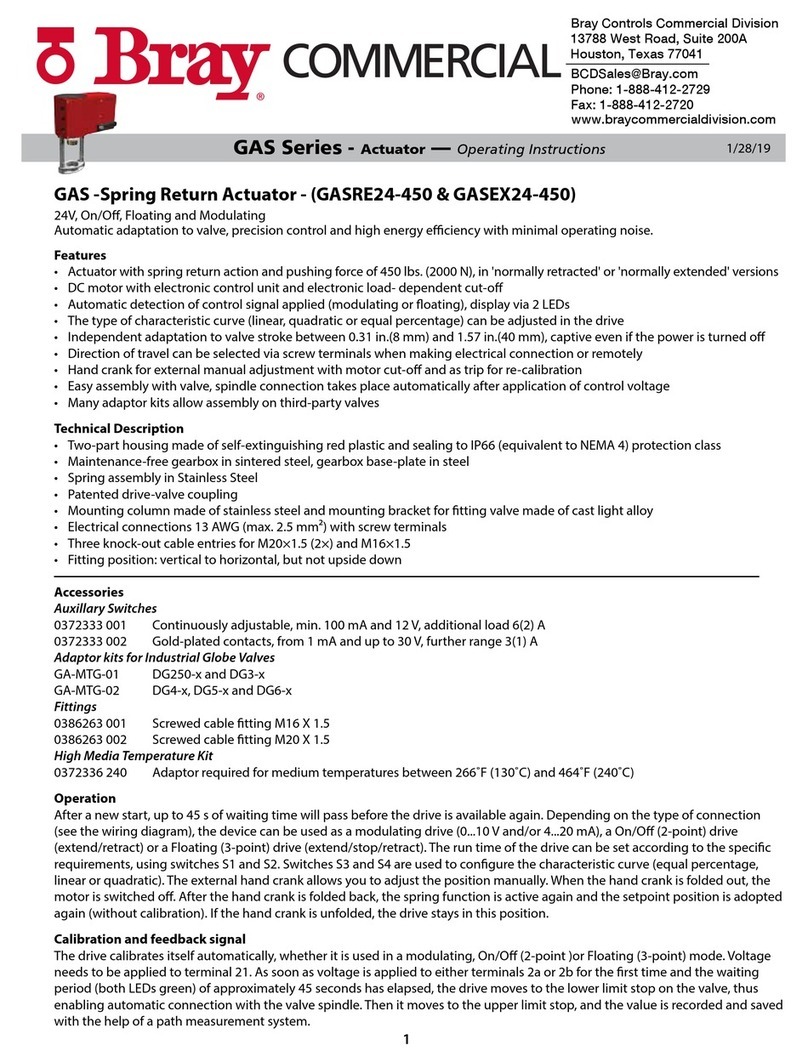
Bray
Bray GAS Series User manual
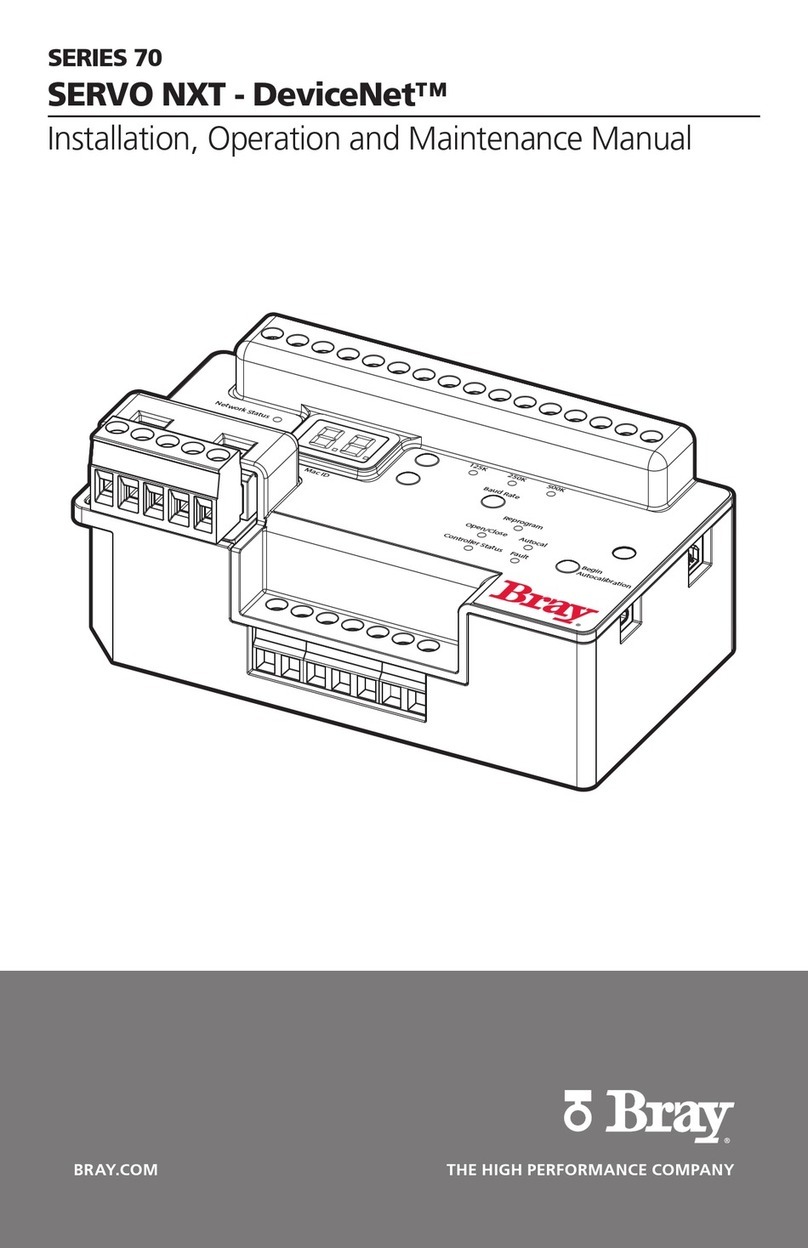
Bray
Bray Series 70 User manual
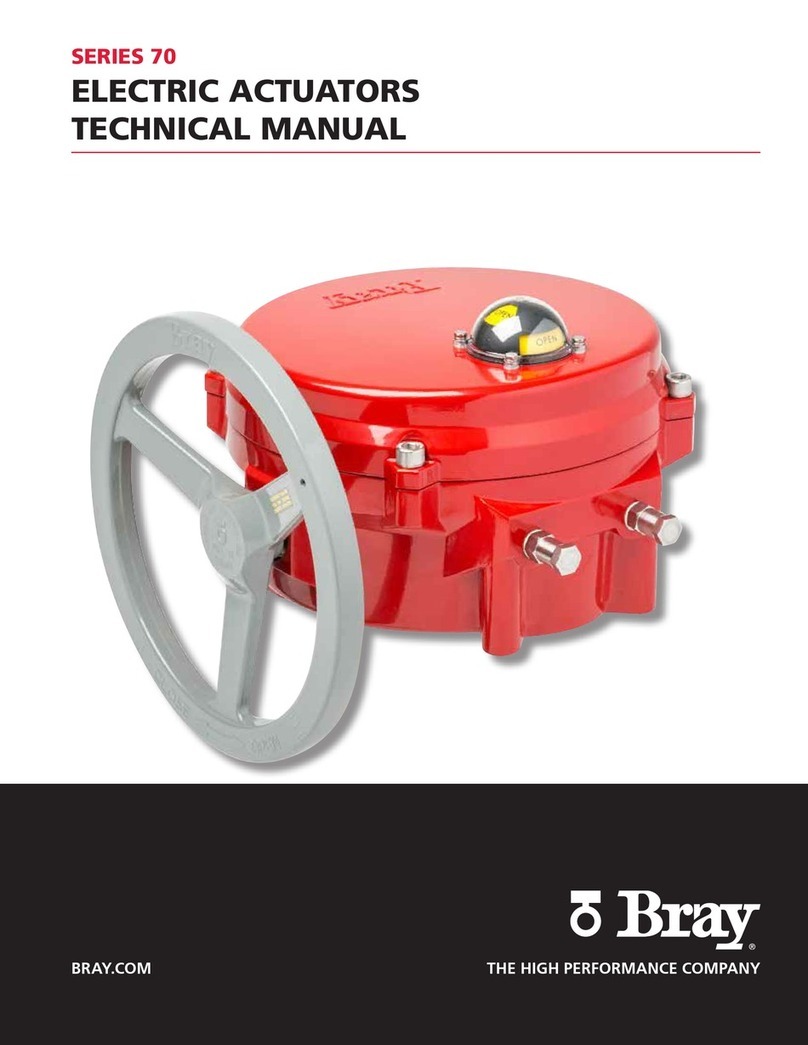
Bray
Bray Series 70 User manual
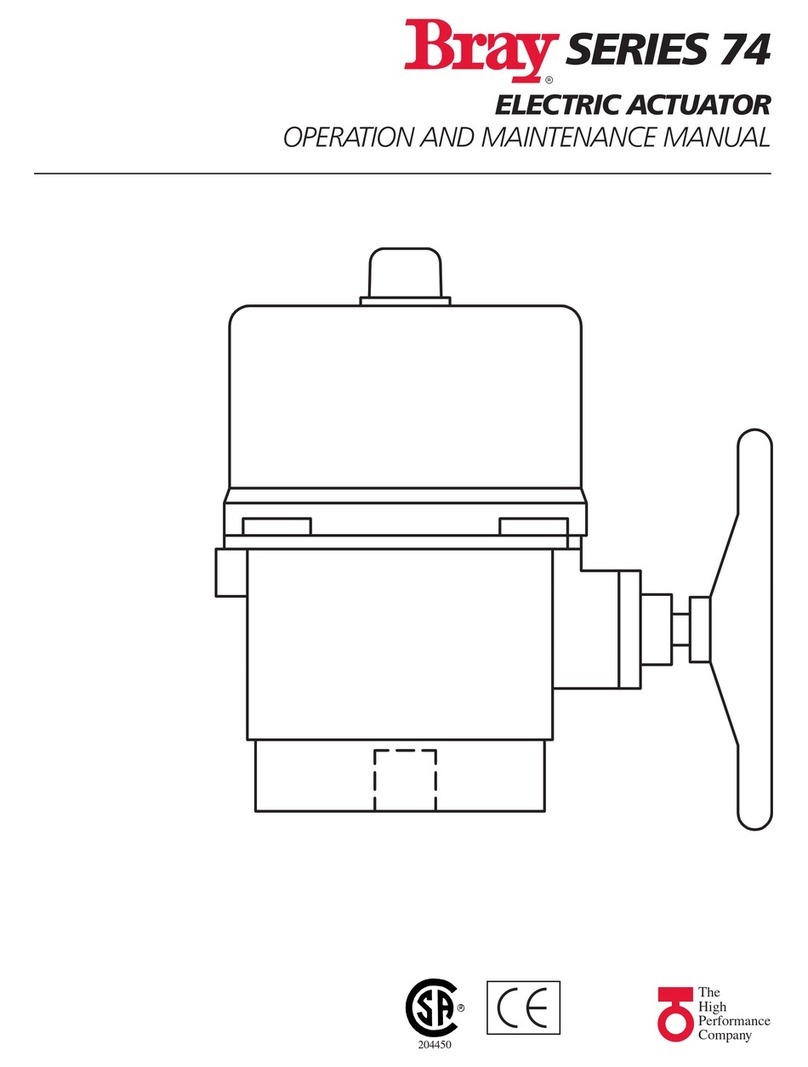
Bray
Bray 75 Series User manual

Bray
Bray Series 70 User manual
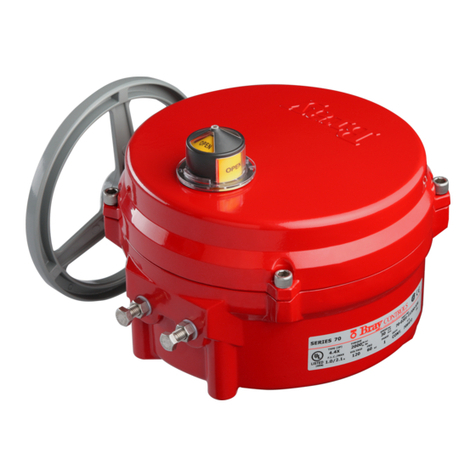
Bray
Bray Series 70 User manual

Bray
Bray SERVO PRO 70 Series User manual

Bray
Bray Series 70 User manual

Bray
Bray Series 70 User manual
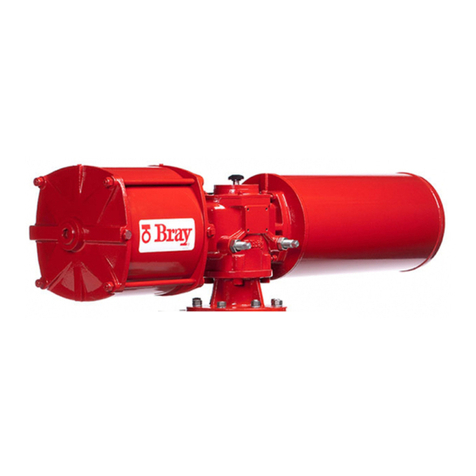
Bray
Bray 98 Series User manual
